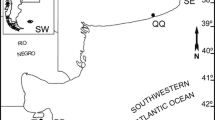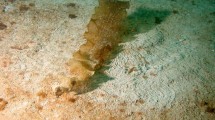Summary
The tops of intertidal boulders on the east coast of Australia may carry a half-dozen algae, while the undersides may support a dozen or more species of sessile animals; mobile forms such as molluscs, crustaceans, and echinoderms are also common. These organisms are disturbed when boulders are moved by waves or buried in sand. Experiments were done to test the hypothesis that these disturbances are responsible for the reduced diversity and abundance of the assemblages on the undersides of small boulders. Boulders on one shore were bolted to the substratum to prevent movement by waves. In two separate experiments on another shore, boulders with and without attached organisms were buried in a few centimetres of sand. All experiments included relevant controls and were done high and low on the shore using rocks of several sizes.
The assemblages of algae developing on the tops of all stabilised boulders, regardless of size, were similar to those on boulders free to roll indicating that, in contrast to results elsewhere, disturbance by waves was too infrequent or slight to affect these species. The tops of rocks were also rarely buried in sand and the main influences on the community in this situation were apparently exposure at low-tide and grazing gastropods.
More species, however, did settle or survive on the undersides of rocks which were free of sand or could not be moved by waves; thus disturbances were important in this situation. In the absence of disturbance low on the shore, much or all space was occupied and sessile species such as sponges and ascidians overgrew other forms and reduced diversity. This did not happen higher on the shore and here diversity was simply an increasing function of rock-size. Overall disturbance played a similar role in all places — it killed organisms and created free space — but the final effects on the community varied depending upon the species present and the actions of other factors.
Similar content being viewed by others
References
Andrew GH (1980) The ecology of lower shore littoral algal communities. Unpublished M.Sc. thesis, University of Sydney, Australia
Brenchley GA (1981) Disturbance and community structure: an experimental study of bioturbation in marine soft-bottom environments. J Mar Res 39:767–790
Connell JH (1972) Community interactions on rocky intertidal shores. Ann Rev Ecol Syst 3:169–192
Connell JH (1975) Some mechanisms producing structure in natural communities; a model and evidence from field experiments. In: Cody ML and Diamond JM (eds) Ecology and Evolution of Communities. Harvard University Press, Cambridge, London
Connell JH (1978) Diversity in tropical rain-forests and coral reefs. Science 199:1302–1310
Connell JH, Keough MJ (1984) Disturbance and patch dynamics of subtidal marine animals on hard substrata. In: Pickett STA and White PS (eds) The ecology of natural disturbance and patch dynamics. Academic Press, New York, pp 125–147
Connell JH, Sousa WP (1983) On the evidence needed to judge ecological stability or persistence. Am Nat 121:789–824
Connor EF, McCoy ED (1979) The statistics and biology of the species-area relationship. Am Nat 113:791–833
Dayton PK (1984) Processes structuring some marine communities: are they general? In: Simberloff DS, Strong Jr DR, Livingston RJ, and Thistle, A (eds) Ecological Communities: Conceptual Issues and the Evidence. Princeton University Press, Princeton, NJ
Fairweather PG (1985) Differential predation on alternative prey, and the survival of rocky intertidal organisms in New South Wales. J Exp Mar Biol Ecol 89:135–156
Fairweather PG, Underwood AJ (1983) The apparent diet of predators and biases due to different handling times of their prey. Oecologia (Berlin) 56:169–179
Fairweather PG, Underwood AJ, Moran MJ (1984) Preliminary investigations of predation by the whelk Morula marginalba Blainville. Mar Ecol Prog Ser 17:143–156
Feyerabend P (1975) Against Method. Humanities Press, Atlantic Highlands
Grime JP (1973) Competitive exclusion in herbaceous vegetation. Nat 242:344–347
Huitema BE (1980) Analysis of Covariance and Alternatives. John Wiley & Sons, Interscience, New York, London
Huston M (1979) A general hypothesis of species diversity. Am Nat 113:81–101
Jackson JBC (1977) Competition on marine hard substrata: the adaptive significance of solitary and colonial strategies. Am Nat 111:743–767
Jackson JBC, Buss LW (1975) Allelopathy and spatial competition among coral reef invertebrates. Proc Nat Acad Sci USA 72:5160–5163
Jernakoff P (1983) Factors affecting the recruitment of algae in a midshore region dominated by barnacles. J Exp Mar Biol Ecol 67:17–31
Keough MJ (1984) Dynamics of the epifauna of the bivalve Pinna bicolor: interactions among recruitment, predation and competition. Ecology 65:677–688
Kuhn TS (1970) The Structure of Scientific Revolutions. University of Chicago Press, Chicago
Lieberman M, John DM, Lieberman D (1984) Factors affecting algal species assemblages on reef and coral substrata of Ghana. J Exp Mar Biol Ecol 75:129–143
Littler MM, Littler DS (1981) Intertidal macrophyte communities from Pacific Baja California and the upper Gulf of California: relatively constant vs. environmentally fluctuating systems. Mar Ecol Prog Ser 4:145–158
Littler MM, Littler DS (1984) Relationship between marcroalgal functional groups and substrate stability in a subtropical rocky — intertidal system. J Exp Mar Biol Ecol 74:13–34
MacArthur RH, Wilson EO (1967) The Theory of Island Biogeography. Monographs in Population Biology, Princeton University Press, Princeton, NJ
McGuinness KA (1984a) The species-area relations of the communities on intertidal boulders: testing the null hypothesis. J Biogeogr 11:439–456
McGuinness KA (1984b) Communities of organisms on intertidal boulders: the effects of disturbance and other factors. Unpublished PhD thesis, University of Sydney, Australia
McGuinness KA (1984c) Equations and explanations in the study of species-area curves. Biol Rev 59:423–440
McGuinness KA (1987) Disturbance and organisms on boulders. I. Patterns in the environment and the community. Oecologia (Berlin) 71:409–419
McGuinness KA, Underwood AJ (1986) Habitat structure and the nature of communities on intertidal boulders. J Exp Mar Biol Ecol (in press)
Menge BA, Sutherland JP (1976) Species diversity gradients: synthesis of the roles of predation, competition and temporal heterogeneity. Am Nat 110:351–369
Osman RW (1977) The establishment and development of a marine epifaunal community. Ecol Monogr 47:37–63
Paine RT (1966) Food web complexity and species diversity. Am Nat 100:65–75
Paine RT (1974) Intertidal community structure: Experimental studies on the relationship between a dominant competitor and its principal predator. Oecologia (Berlin) 15:93–120
Paine RT, Levin SA (1981) Intertidal landscapes: disturbance and the dynamics of pattern. Ecol Monogr 51:145–178
Pickett STA, White PS (1984) Patch dynamics: a synthesis. In: Pickett STA and White PS (eds) The ecology of natural disturbance and patch dynamics. Academic Press, New York, pp 371–384
Riedl R (1964) Die Erscheinungen der Wasserbewegung und ihre Wirkung auf Sedentarier im mediterranen Felslitoral. Helgol Wiss Meeresunters 10:155–186
Rutzler K (1965) Substratsastabilitat im marinen Benthod als okologischer Factor, dargestellt am Beispieladriatischer Porifer. Int Rev Ges Hydrobiol 50:818–827
Simberloff DS (1974) Equilibrium theory of island biogeography and ecology. Ann Rev Ecol Syst 5:161–182
Sousa WP (1979a) Experimental investigations of disturbance and ecological succession in a rocky intertidal algal community. Ecol Monogr 49:227–254
Sousa WP (1979b) Disturbance in marine intertidal boulder fields: the nonequilibrium maintenance of species diversity. Ecology 60:1225–1239
Sousa WP (1980) The responses of a community to disturbance: the importance of successional age and species life histories. Oecologia (Berlin) 45:72–81
Sousa WP (1984) The role of disturbance in natural communities. Ann Rev Ecol Syst 15:353–392
Taylor PR, Littler MM (1982) The roles of compensatory mortality, physical disturbance, and substrate retention in the development and organization of a sand-influenced, rocky intertidal community. Ecology 63:135–146
Thistle D (1981) Natural physical disturbances and communities of marine soft bottoms. Mar Ecol Prog Ser 6:223–228
Turner T (1983) Complexity of early and middle successional stages in a rocky intertidal surfgrass community. Oecologia (Berlin) 60:56–65
Underwood AJ (1980) The effects of grazing by gastropods and physical factors on the upper limits of distribution of intertidal macroalgae. Oecologia (Berlin) 46:201–213
Underwood AJ (1981) Techniques of analysis of variance in experimental marine biology and ecology. Oceanogr Mar Biol Ann Rev 19:513–605
Underwood AJ, Denley EJ (1984) Paradigms, explanations and generalizations in models for the structure of intertidal communities on rocky shores. In: Abele LG, Simberloff DS, Strong DR, Thistle AB (eds) Ecological Communities: Conceptual Issues and the Evidence. Princeton University Press, Princeton, New Jersey, pp 151–180
Underwood AJ, Denley EJ, Moran MJ (1983) Experimental analyses of the structure and dynamics of mid-shore rocky intertidal communities in New South Wales. Oecologia (Berlin) 56:202–219
Underwood AJ, Jernakoff P (1981) Effects of interactions between algae and grazing gastropods on the structure of a low-shore intertidal algal community. Oecologia (Berlin) 48:221–233
Underwood AJ, Jernakoff P (1984) The effects of tidal height, wave-exposure and rock pools on grazing and the distribution of intertidal macro-algae. J Exp Mar Biol Ecol 75:71–96
VanBlaricom GR (1982) Experimental analyses of structural regulation in a marine sand community exposed to oceanic swell. Ecol Monogr 52:283–306
Williams CB (1943) Area and the number of species. Nature 152:264–267
Winer BJ (1971) Statistical Principles in Experimental Design (second edition). International Student Edition. McGraw-Hill Kogakusha Ltd, Tokyo
Author information
Authors and Affiliations
Rights and permissions
About this article
Cite this article
McGuinness, K.A. Disturbance and organisms on boulders. Oecologia 71, 420–430 (1987). https://doi.org/10.1007/BF00378716
Received:
Issue Date:
DOI: https://doi.org/10.1007/BF00378716




